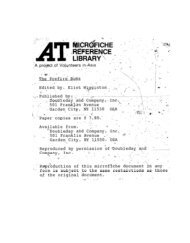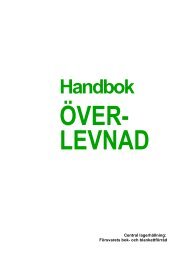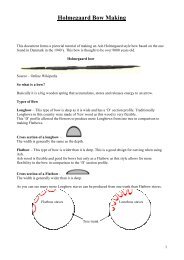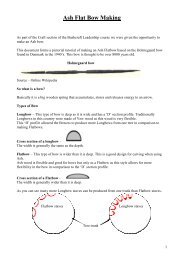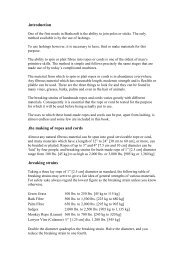Experiments on Knife Sharpening John D. Verhoeven ... - BushcraftUK
Experiments on Knife Sharpening John D. Verhoeven ... - BushcraftUK
Experiments on Knife Sharpening John D. Verhoeven ... - BushcraftUK
You also want an ePaper? Increase the reach of your titles
YUMPU automatically turns print PDFs into web optimized ePapers that Google loves.
Appendix 1Edge angle measurements with a laser pointerA relatively crude but effective device was built to measure the 2α and 2β edgeangles utilizing a laser beam. A simple laser pointer, sold for a pointing device whengiving a lecture, was mounted as shown in Fig. A1. The diagram shows how the laserbeam is reflected to the 2 sides of the knife edge. The deflected beams strike thecalibrated cross board at specific locati<strong>on</strong>s, which can be seen well in a lighted room.Scratches <strong>on</strong> the edge cause the beam spot to become blurry. The sharpness of deflectedspots revealed in a darkened room were found useful in evaluating the edge smoothness.The device allowed the distance of the cross board from the knife edge to be adjusted tomaintain a fixed value of X. The distance of a deflected spot from the zero defecti<strong>on</strong>point of the laser beam, called d, is related to the face angle, say α, as:α 1 = [arc tangent (d(α 1 )/X)]/2, where 2α = α 1 + α 2Crossboardd(β 1)d(α 1)Zerodeflecti<strong>on</strong>d(α 2)d(β 2)Laser pointerCalibratedscalexBladeholderFigure A1 Schematic diagram of the laser device used to measure theface angle 2α and the edge angle 2β.Using this equati<strong>on</strong> a scale calibrated in degrees was pasted to the cross board. Values ofthe 4 angles, β 1 , α 1 , α 2 , and β 2 can be read directly from the scale.47



